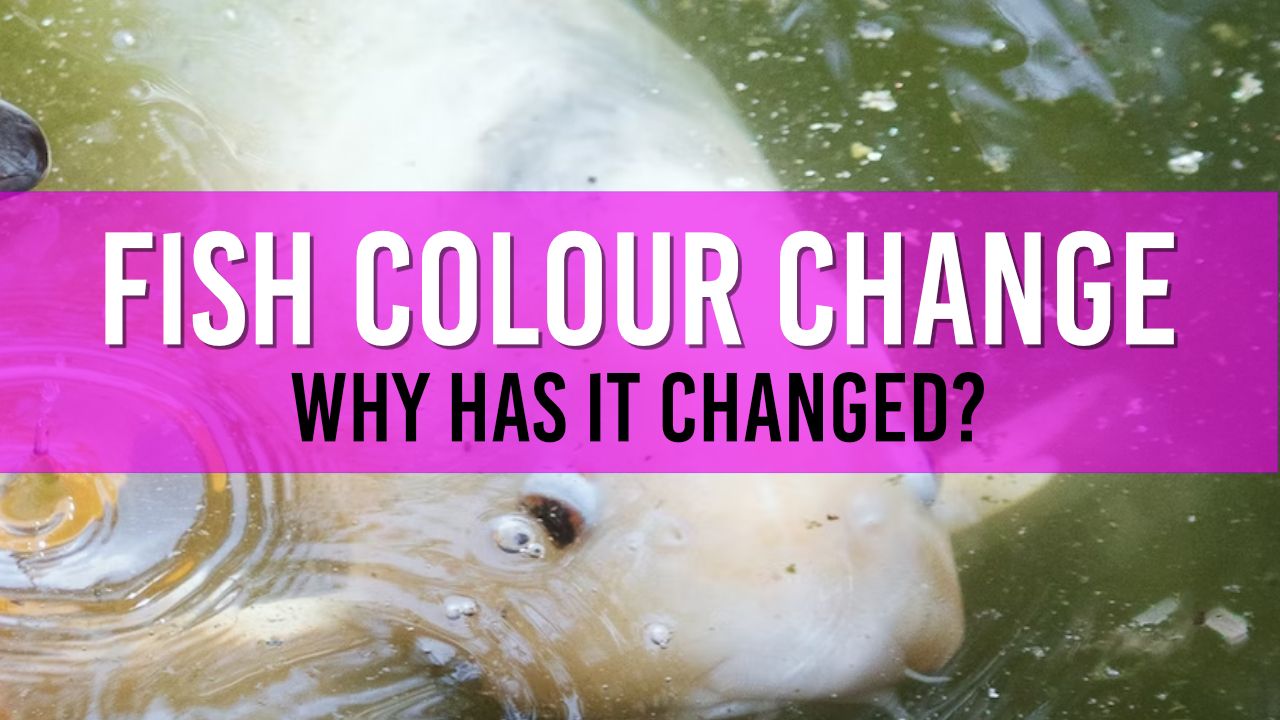Decoding Colour Changes in Pond Fish: Common Causes and Insights
If you've noticed your fish has recently changed colour (or lost its colour), it could be sign of stress, age, diet or overall health. It could also just be genetics.

Table of Contents
As a pond owner for several years, I've often encountered various questions and concerns about fish health and pond maintenance. One common question that many pond owners have is, "Why has my fish changed colour?" This article aims to explore the possible reasons behind this intriguing phenomenon and provide helpful tips to address it.
At a Glance
| Section | Quick Details |
|---|---|
| Importance of Colour Changes | Fish colour can hint at health issues, stressors, or natural processes. |
| Causes of Colour Changes | Factors include age, water quality, dietary changes, health conditions, and external stressors. |
| Immediate Actions | Check water quality, assess fish diet, and monitor their behaviour for distress signs. |
| Preventative Measures | Maintain consistent lighting, clean the pond regularly, and provide a steady, balanced diet. |
| Additional Insights | Some fish change colour naturally with age. Avoid overcrowded ponds. Seek expert advice when needed. |
| Time Estimates | Immediate interventions take about 15-45 minutes; regular care varies based on pond specifics. |
Why Are Colour Changes in Pond Fish Important?
Significance of Fish Health and Colour
The hue of a fish is intricately linked to its overall health and well-being. Understanding the connection between a fish's colouration and its health status is crucial for responsible pond ownership. Changes in colour can serve as a visible indicator of underlying health issues, prompting us to take necessary action.
Detecting Behavioural Changes in Fish
In addition to altered colouration, shifts in behaviour and appetite can often accompany these changes. These behavioural shifts provide further insights into the health and comfort of your fish. Recognizing these signs and addressing them promptly is essential for maintaining a thriving pond ecosystem.
Environmental Stressors Affecting Fish Colour
The environment in which your fish reside plays a pivotal role in determining their appearance. Factors such as sunlight exposure, temperature fluctuations, and water quality can exert a profound influence on their colouration. Being mindful of these environmental stressors is vital for ensuring the vibrant and healthy appearance of your aquatic companions.
What Causes Colour Changes in Pond Fish?

- Age and Maturation Impact on Fish Colour: Fish, like many living beings, change as they age.
- Environmental Impacts (Lighting & Water Quality): The surroundings are key to a fish's hue.
- The Role of Diet in Fish Colour: Diet directly impacts vibrancy and health.
- Illness or Parasites and Their Effect on Colour: Health issues can often disguise themselves as mere colour changes.
- How Stress or Injury Can Alter Fish Colour: Stressors or physical harm can lead to colour alterations.
Imagine you've planted a seed and watched it grow. Over time, it changes, blossoms, and even bears fruit. Similarly, your pond fish evolve and transform as they journey through their lifecycle. However, just as an unexpected frost might harm your budding plants, sudden shifts in the pond's environment can affect your fish. Water quality, much like soil quality, is vital.
A sudden surge in ammonia or a dip in pH levels can be just as impactful as a spell of drought on your flowerbeds. And let's not forget the diet! Just as you'd provide the best compost for your plants, ensuring a nutritious diet for your fish is equally crucial. Spotting and understanding these causes is our first step in ensuring our fish remain as vibrant as the flowers in spring!
Immediate Actions to Take if Your Pond Fish Changes Colour:
Assessing Water Parameters in Ponds
Check levels of pH, ammonia, and nitrates in your pond to ensure a healthy environment for your fish.
Dietary Considerations for Vibrant Pond Fish

Ensure your pond fish receive a balanced, nutritious diet to maintain their vibrancy and health.
Consider the diet of your pond fish. Just as a rose might not bloom as brightly without the right nutrients, your pond fish require a balanced diet to remain healthy and vibrant.
Monitoring Pond Fish for Signs of Distress
Keep a vigilant eye on the behaviour and physical signs of your pond fish to detect any signs of distress.
Responsiveness to Changes in Pond Fish

When you spot a drooping plant in your pond, you don't wait; you take immediate action. Similarly, when your pond fish show signs of colour change, it's crucial to act promptly. Just as you'd check if a pond plant has adequate water or if the soil is too dry, your initial step with fish should be to assess the water parameters. An imbalance in these parameters can often be the root cause of issues.
Understanding Behavioural Signs in Pond Fish
Always be attentive to their behaviour. If your pond fish are hiding more frequently or eating less, it might be their way of signalling, “Hey, something's not right!”
Additional Insights for Keeping Colourful Pond Fish
Natural Colour Changes in Fish Lifecycle

In the grand tapestry of nature, change is an undeniable constant. Just as trees shed their leaves and flowers bloom and wither, the lifecycle of fish is marked by its own intriguing transformations. As fish grow and age, it is only natural that they undergo shifts in colouration. These shifts, akin to the vibrant changes of leaves in autumn, add a unique beauty to their presence in your pond.
The Detriments of Overcrowded Ponds

Maintaining the well-being of your pond's vibrant inhabitants requires providing them with ample space to swim freely. Just as a crowded garden can stunt the growth of its plants, an overcrowded pond can lead to stressed and unhealthy fish. Prioritizing their comfort and spacious environment is essential to ensure that your fish remain lively and radiant.
Summary
As every gardener understands the language of plants, it's equally vital to decipher the changing hues of our pond fish. Why do pond fish change colour? It's a question as intricate as nature itself. Just as flowers and foliage communicate through colours, pond fish, too, offer vibrant clues about their health, environment, and well-being.
From natural ageing processes and water quality to their dietary habits and potential health conditions, there are myriad reasons for these fascinating transformations. Immediate steps like assessing water parameters and ensuring a balanced diet can often address the root cause.
Regular pond maintenance and expert insights ensure our fish remains as radiant as a well-tended garden. Whether it's a fleeting shade or a persistent hue, understanding these changes is essential for every pond enthusiast. Dive into the article to uncover the world of colours beneath the water's surface!

